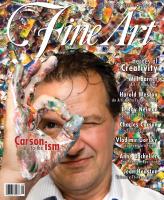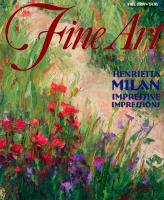| Notas bibliograficas |
Christian SORRIANO, Paris
Louis BRUENS, Canada
FINE ART MAGAZINE, USA
Béatrice SZEPERTYSKI - Bordeaux
Jamie Ellin Forbes- USA
GUY ROBERT, Canada
Champlain CHAREST, CAN
Jacques de ROUSSAN, CAN
ROBERT BERNIER, Canada
Paola TREVISAN - Italia
Lise GRONDINES, Canada
Caroline BRUENS, Canada
Alain COUDERT, France
Anne RICHER, Canada
Colette RICHELIEU, Canada
Florentina LUNGU, B.A, M.A.
Laura MARBOT- Bordeaux
Denise Di CANDIDO, Canada
Arévik VARDANYAN, Canada
Léonel JULES, Canada
Frédéric BONET, France
Jacqueline DE TORRES, France
Anne-Marie LAURÈS, France
Louis LEFÈVRE, France
Académie (AIBAIQ), Canada
ACADEMIA DU VERBANO, Italia
Firma del maestro según diverso período.
|
|
| |
 |
|
| Fine Art Magazine - Spring 2009 - USA - Page couverture - Charles Carson - Heroes of creativity |

Fine Art Magazine - Spring 2009 - USA - Page couverture - Charles Carson - Heroes of creativity
|
|
Fine Art Magazine - Spring 2009 - USA
Charles Carson « Heroes of creativity »
Carson to the ism
The brilliant analysis of «Carsonism» proposed in the FineArt magazine allows collectors to discover an angle that only experimented writers and the bold view points of Jamie Ellin Forbes & Victor Bennet Forbes could reveal. A true literary jewel. On the front page, as part of the creative heros, we find Charles Carson.
“In a mosaic technique work like «Vibrations florales» there is so much happening. How does one consolidate miniscule droplets of floral energy into such a complex solution of color? He is not revealing any secrets, any more than you would know if Pollock had a plan when he dripped all that paint, or if Vincent knew exactly where he was going when he produced the first star in Starry Night. No one can say for sure, but what Carson does share with the aforementioned artists is total devotion to painting.”
|
| Artículo completo |
|
| Fine Art Magazine - Fall 2009 - USA |

Fine Art Magazine - Fall 2009 - USA
|
|
Fine Art Magazine - Fall 2009 USA
Carson, page, 5,6,7
This is “Carsonism…”
By VICTOR FORBES
“...Because the colors are incredibly clean, there’s a tempo. You can’t just paint and you can’t extra-polate unless you know form; you have to know form, you have to be able to paint in order to extrapolate. Carson applies the paint with a tempo and a sense of color as if the light were coming through. The pieces are very energetic, almost kinetic—and there’s a definite form lent through the application of the color. I don’t know what Mr. Carson has in his mentality as he paints, but it looks to
me as if he’s painting the subconscious vision of what he sees; that he steps into the space between space, the dream space—and starts to paint the colors as they vibrate, as one form transitions from dream to reality and reality to dream and the abstract in-between. The colors are incredibly clean, which is rare—and they are built, have definition and are textural. You would think that it’s simple, but it is not. This is a very complex and difficult mode of expression to arrive at and you have to have an understanding of harmony and tempo to have a significant balance throughout the piece in order to create the composition. The result is the school of thought Carson is forming—Carsonism, Carson to the ism.” There are elements to this work that I have not seen elsewhere. I have not seen this technique done elsewhere. Have you?
“Isn’t this the founding of a thought process or a school? Did anybody do Braque or Leger, or Pollock before they did themselves?”
|
| Artículo completo |
|
|

